The Angelbird Wings PX1 M.2 Adapter Review: Do M.2 SSDs Need Heatsinks?
by Billy Tallis on December 21, 2015 8:00 AM ESTRandom Write
The random write test runs for a total of 18 minutes, starting with a queue depth of 1 and doubling QD every three minutes. The test is limited to a 16GB portion of the drive and only that portion is pre-filled with data, so this test doesn't reflect the steady-state behavior of a full drive. The main scores are based on the average of QD1, QD2 and QD4 results as larger queue depths are rare for client workloads. A more detailed breakdown is graphed further down the page.
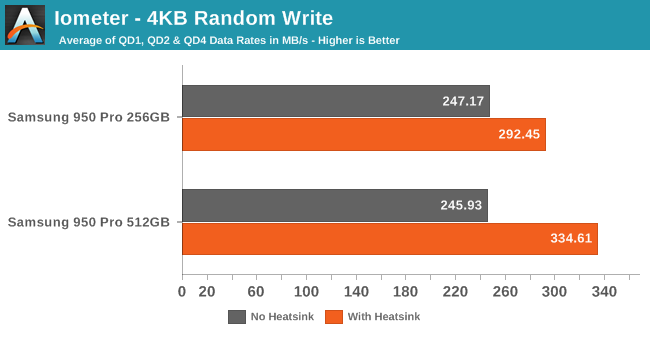
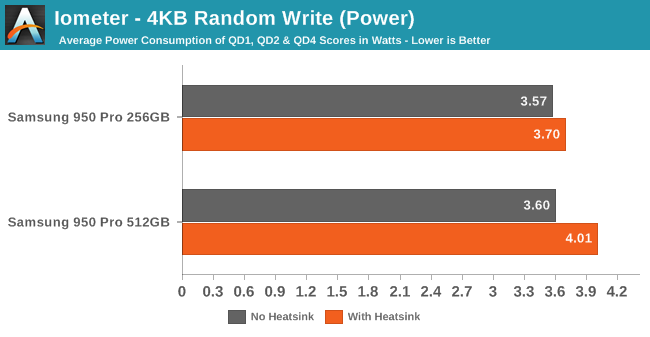
The heatsink allows the 950 Pro to reach significantly higher random write speeds, and enables the larger 512GB model to pull ahead of the 256GB model. Power comsumption increased slightly, but given the performance boost, efficiency is improved.
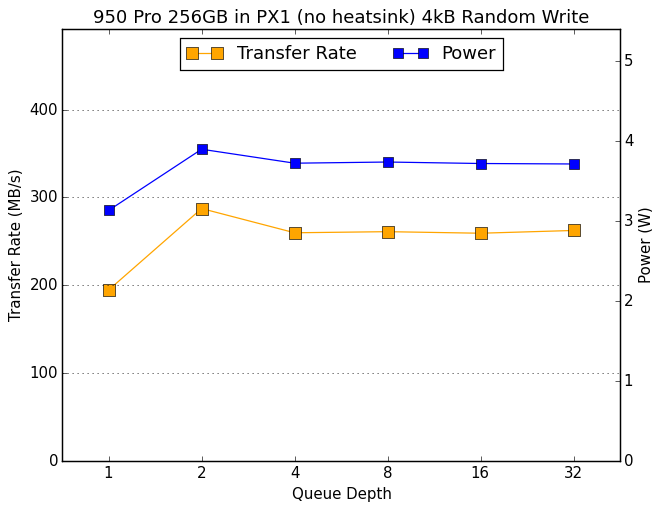 |
|||||||||
| 256GB no heatsink | 512GB no heatsink | ||||||||
| 256GB with heatsink | 512GB with heatsink | ||||||||
Without the heatsink, performance drops starting with a queue depth of 4, indicating that thermal throttling kicks in severely 6 to 9 minutes into the test. With the heatsink, we see that the 512GB model doesn't reach full performance until QD4.
Random Read
The timing and queue depth scaling for testing random reads are handled the same as for random writes, but reads are inherently faster and less power-hungry operations than writes for flash memory, so this is usually a less stressful test even when the drive's throughput is higher. The entire drive is filled before this test and the reads are not restricted to any portion of the drive.
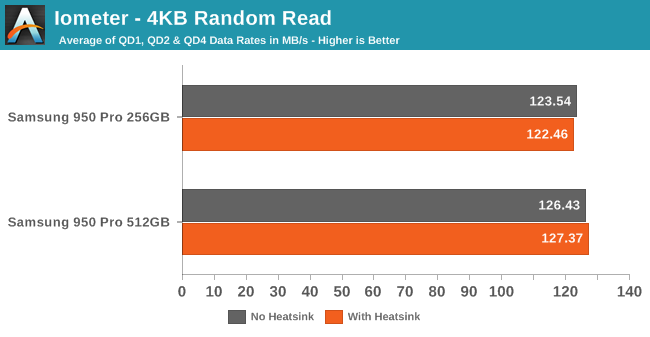
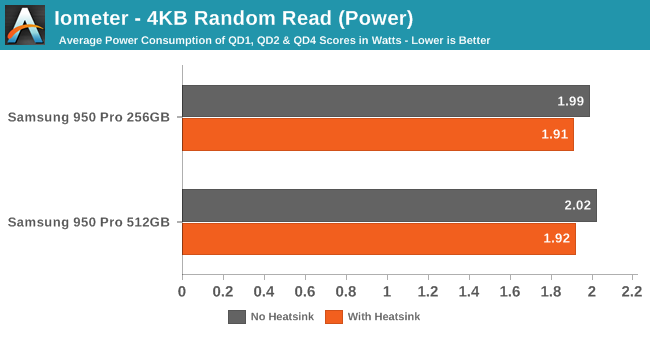
The performance for random reads is unaffected by the heatsink, but the lower operating temperature leads to less transistor leakage and thus slightly improved efficiency.
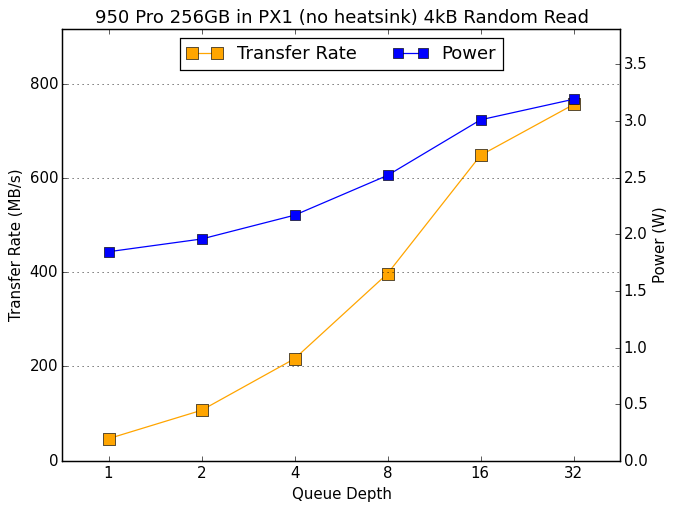 |
|||||||||
| 256GB no heatsink | 512GB no heatsink | ||||||||
| 256GB with heatsink | 512GB with heatsink | ||||||||
The heatsink produces no meaningful changes to the queue depth scaling behavior of random reads, further demonstrating that heat is not a problem for this test.










69 Comments
View All Comments
Billy Tallis - Monday, December 21, 2015 - link
Unfortunately, the only high-quality thermometer I have is the temperature probe for the multimeter that was busy doing the power measurements. I'll be getting some kind of thermometer soon, and I'm open to suggestions of something with data logging capability. Otherwise I'll get a cheap IR thermometer and you'll have to be satisfied with just a few spot readings instead of the full graph we'd both rather see.defaultluser - Monday, December 21, 2015 - link
I wonder if you could compare the performance of this heatsink versus just pointing a quiet 80mm fan at the drive? More moving air can have the same effect as much larger surface area, especially if we're only talking about half a watt extra required to reach full performance.ronboberg - Monday, December 21, 2015 - link
So, basically they just need an extension cable/riser for the M.2 slot (they can do it for normal pci-e slot, these are basically the same thing but smaller) so you can relocate the drive in a normal drive bay to keep it cooled off. Or if they started out with something like a real cable going to a slightly modified M.2 connector that would be purposed for just drives on the board in the first place they could make normal 2.5" size drives with the new connector, 2TB+, and all the advantages that goes with being bigger and able to be placed like a normal drive. If you don't have the space, the small boards could still have the universal M.2 slot they have now for the bubblegum stick size drives but would just have to put up with the heat.extide - Monday, December 21, 2015 - link
We already have what you are asking for: U.2tipoo - Monday, December 21, 2015 - link
I wonder how this compares to just slapping these on the relevant chipshttp://www.newegg.com/Product/Product.aspx?Item=N8...
Zak - Monday, December 21, 2015 - link
As few posters mentioned already: there is no room for even the tiniest heatsink.MrSpadge - Monday, December 21, 2015 - link
Of course there is enough space: the chip packages themselves. It won't work in a laptop, but for a desktop some simple small memory heatsinks should do the trick just as well. for 5$ (aluminum is sufficient instead of copper) instad of 75$. And never mind if the heat sink overlaps the chips a bit, just make sure it doesn't short anything on the mainboard (use some insulation tape as needed).tipoo - Monday, December 21, 2015 - link
Final words page, should the with and without heatsinks be flipped? If it was thermally shackled, should the higher bar not be for the one *with* the heatsink and not without?http://images.anandtech.com/graphs/graph9856/79399...
tipoo - Monday, December 21, 2015 - link
*for the 512GB drive at least, the 256 seems rightThe_Assimilator - Monday, December 21, 2015 - link
I think you are correct, I also noticed it and had a "huh, WTF?" moment.